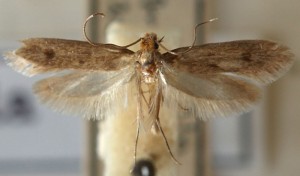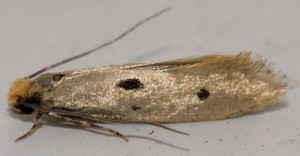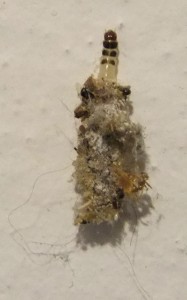Facts About Case-bearing Clothes Moths
Occurrence: Case-bearing clothes moth (Tinea pellionella) are, along with the common clothes moth, the two most common pest moths in the UK.
Diet: It is the larvae of these moths that cause damage. They feed primarily on fur, hair, feathers, and textiles but can also consume other materials such as dried food items.
Control: The key to controlling these moths is cleanliness. All areas of the home where the moths might develop should be thoroughly cleaned. Moth traps can also be useful, but insecticides are generally discouraged. Below is more information on how to deal with moth infestations.
How to Control Case-bearing Clothes Moths
If you notice moths flying around your home, it's almost a sure sign of an infestation. To prevent them from multiplying, you should kill all the adult moths you see.
However, the problem won't be fully solved until you also remove the moth eggs and larvae, which is best done through thorough cleaning of the home.
Cleaning the Home
The best way to prevent moths from establishing themselves in your home is by cleaning. One of the most important tools for this is a vacuum cleaner with a brush head to remove hair, dust, and other materials that moths can feed on.
Pay special attention to the following areas when cleaning:
- Wardrobes (especially clothes storage)
- Drawers (especially clothing drawers)
- Carpets
- Upholstered furniture
- Under all furniture
- Cracks between walls and ceilings
- Ceiling moldings, trims, etc.
- Curtains
- Corners and hidden spots
- Baseboards and doorframes
If you suspect or detect a moth infestation, dispose of the vacuum bag immediately in an outdoor trash bin to minimize the risk of moths spreading.
Clothes and Textiles
Thoroughly inspect clothes and places where clothes are stored. Clothes that are not frequently used should be sealed in airtight paper or plastic bags. It’s crucial that the clothes are moth-free when packed.
Consider the following places for cleaning:
- Clothes wardrobes
- Clothes drawers
- Fur coats and other fur clothing
- Bedding, tablecloths, and fabric napkins
- Wool clothing and yarn
If you find clothes or textiles with signs of moths, you can kill the eggs, larvae, and moths by:
- Washing the clothes in a washing machine at a minimum of 50°C
- Dry cleaning at a professional cleaner
- Freezing the items at -18°C or lower for 2 days
Remember to vacuum all drawers and wardrobes where the clothes were stored. You can also treat these storage areas with moth control products, but be cautious about using chemical products around clothing. Instead, consider placing moth traps in drawers and wardrobes.
The Kitchen
When cleaning the kitchen, you should also check dry foods in kitchen cupboards such as spices, cereals, seeds, tea, etc. for any signs of the presence of fur mites. They can also be found in other stimulants such as tobacco.
If there are signs of case-bearing clothes moth in your dry goods, you should discard them immediately and get rid of the rubbish bag straight away. In addition, all kitchen cabinets should be thoroughly cleaned (both vacuuming and scrubbing) and you should consider where the moths are coming from; it could be the store, warehouse, manufacturer, neighbour or your own home! Case-bearing clothes moths in food should always be controlled where they originate.
Furniture and Pets
If you have pets, their bedding (dog baskets, cat beds, rabbit cages, etc.) should be cleaned regularly. This also applies to other areas where pets spend a lot of time, like doghouses or scratching posts. Other furniture and items where moth larvae might thrive include:
- Carpets
- Furniture
- Home ventilation
- Stuffed animals
- Animal trophies
- Insect collections
It's also a good idea to check the basement, attic and garage for case-bearing clothes moth – especially if you store any kind of textiles, upholstered furniture etc. here.
If you discover case-bearing clothes moth in your furniture or carpets, beat them with a carpet beater and brush them. They should then be vacuumed. If the weather is freezing, it's a good idea to leave the furniture outside at night and bring it inside during the day for a couple of days. The changing temperatures effectively kill eggs, larvae and moths, which can otherwise survive a few days in freezing weather.
Many pieces of furniture are treated with cedarwood oil to keep moths at bay, but the effect of the oil diminishes over time and in theory you should treat your furniture with a cedarwood product every two years. Of course, this can be more work, but if you have a recurring problem with moths in certain furniture, you should follow this advice.
We generally advise against the use of chemical moth repellents, as they are typically harmful to both the environment and health and have a limited effect. Read more about this in our article on moth sprays.
Other Areas to Inspect
Unlike the clothes moth, which originates from warmer countries, the case-bearing clothes moth is native to the UK countryside. Therefore, the moth is adapted to our surroundings and is found in bird nests, among other places. Therefore, abandoned bird nests near your home should always be removed if you have problems with case-bearing clothes moths.
Rodents and all other pests (especially insects such as bees and wasps) should also be controlled, as case-bearing clothes moth larvae can feed on rodent fur, insect exoskeletons, etc.
Dead pests such as rats or mice (or bats) can also give rise to case-bearing clothes moth infestations as the moths can feed on dead rodents. For example, if you have used poison against rats or mice, chances are that you have one or more dead rodents lying in an inaccessible place in or around your home, which can give case-bearing clothes moths the opportunity to establish themselves.
Description of the Moth
Adult moths are 0.5 – 0.8 cm long with a wingspan of 1.2 – 1.7 cm.
Full-grown moths have 3 dark spots on each wing, but these spots may be less visible if the wing scales have been worn off. The hind wings are smaller than the forewings and are also more ‘fringed’ with hair and scales.
Male moths are smaller and lighter in colour than female moths. Males also fly around more actively than females and the latter tend to fly only short, interrupted distances.
Both sexes are also shy, which means that their presence may not be immediately noticeable.
Case-bearing clothes moth larvae are white and have reddish-brown heads.
Case-bearing clothes moth eggs are very small and fragile and are destroyed by normal cleaning (e.g. vacuuming, beating, brushing, etc.). Both eggs and larvae are barely visible to the naked eye and when people claim to have seen them, it is usually the larvae's faeces.
Case-bearing clothes moth larvae spin cocoons that they live in and carry around with them – in other words, they wander in their cocoons. They are often overlooked because their cocoons are roughly the same colour as their food source (i.e. the fur or textile they feed on). When they start to migrate – and find themselves on materials other than their food source (such as walls) – they immediately become more visible.
Confusion With Other Moths
Case-bearing clothes moths are roughly the same size as clothes moths and the two can easily be confused – especially if the case-bearing clothes moth has lost its black wing spots. Besides the wing spots, the most obvious difference between the two is that case-bearing clothes moths are more brownish in colour than clothes moths.
However, the larvae of the two moth species are easily distinguishable; the case-bearing clothes moth larva wanders and drags its cocoon around, while the clothes moth larvae do not.
Case-bearing clothes moths can also be confused with brown house moth, however, they have several dark spots on their wings, whereas case-bearing clothes moths only have 3 spots on each wing. Seed moths are generally larger than case-bearing clothes moths and their wingspan is significantly larger.
Signs of an Infestation
The following are the most common signs of case-bearing clothes moth presence in the home:
- Webs
- Cocoons
- Excrement
The above are typically found on clothing, fur, furniture upholstery, ceiling parts, etc. In each location, the presence of case-bearing clothes moths can be seen in the following ways:
- Clothing: Webs, cocoons or excrement on clothing in wardrobes or drawers (typically on hanging clothes). Clothes may have holes, although these are usually caused by clothes moths.
- Fur: Fur clothing will typically have large patches of missing fur (furless areas). This is because the larvae bite the fur hairs at the root and they then fall off. Because the caterpillar then moves on to the neighbouring hairs, the fur loss manifests itself in the form of patches. Webs, cocoons and faeces can be difficult to see in fur because they can be hidden between the fur hairs.
- Upholstery: Case-bearing clothes moth larvae mostly attack upholstery from the dark inside. From the outside, this is visible as individual threads in the upholstery break. On the inside are webs, cocoons and faeces.
- Ceiling parts: webs and cocoons are found in the cracks between walls and ceiling, and possibly also in corners and ceiling parts such as panelling, mouldings, stucco, etc.
Larvae and eggs are difficult to spot due to their minimal size and because they are usually well hidden.
Case-bearing clothes moth larvae drag their cocoon behind them and often settle in the cracks between the walls and ceiling
Life Cycle of the Case-bearing Clothes Moth
Female moths generally live slightly shorter lives than male moths and for both sexes, the maximum lifespan is around 1 month.
- Eggs: Female moths lay between 40 and 300 eggs* in their lifetime. Male moths live slightly longer than female moths, but no more than a month. The eggs are typically laid in between hairs in fur, carpets etc. or in folds, creases, seams etc. Whether larvae hatch from the eggs depends largely on the temperature. Under normal or favourable conditions this time is 4 – 8 days. At freezing (0 degrees) or sub-zero temperatures, the eggs do not hatch and die in about 3 weeks.
- Larvae: The case-bearing clothes moth caterpillar spins a cocoon that it carries with it. When the case-bearing clothes moth caterpillar is fully grown, it often migrates with a tendency to move upwards. It often settles in the cracks between the walls and ceiling as well as in ceiling areas such as mouldings, stucco and the like. Its length here is 6 – 9 mm. Read more about moth larvae here.
- From larva to moth: Under optimal conditions (around 26 degrees and with the right humidity), a larva can develop into a fully grown case-bearing clothes moth in 6 weeks. However, this is rarely the case and will typically take 8-10 weeks in summer and several months in winter. In heated homes where the temperature is fairly constant and the moths have good access to food, the development time can easily be 8-9 weeks.
- Generations: There are about 2 generations per year, but under optimal conditions up to 4 generations can develop per year.
*The amount of eggs varies in several sources and some sources state them to be as low as 40 – 50 on average per female moth, while others state that the number is as high as 300. Our figures therefore represent the minimum and maximum from the sources used. You can read more about the moth life cycle here.



